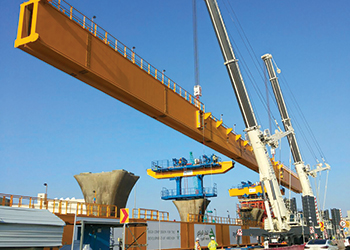
A newly formed partnership between Abloy, a leading manufacturer of locks, locking systems and architectural hardware, and Bahrain-based Janada Electronics, aims to bring the next generation of high security systems and foolproof access control solutions to the country.
“The powerful partnership with Janada Electronics as the authorised agent will see the provision of holistic access control in the kingdom, to all industries and sectors, including government and public services,” says a spokesman for Abloy.
Set up in 2008, Janada Electronics provides safety and security for communities and customers through innovative equipment and technology, maximising efficiency of cost. The company says it can respond to the security needs of any situation in the home, workplace or public sphere.
The partnership is introducing Abloy’s Protec 2 Cliq key system, resilient cylinders, weatherproof padlocks, as well as the EL-560 and EL-420 electromechanical and moto lock solutions into the market.
“Abloy secures millions of homes and public buildings all over the world. Both the trust users place in us and our pioneering position are based on a long-term endeavour, continuously developing new and innovating locking solutions and door-opening technologies that facilitate smooth, and safe entry and exit,” says Noury Bazido, regional manager Abloy.
He says Abloy products are robust and futuristic, striking the perfect balance between providing pre-emptive and pre-set solutions whilst remaining highly scalable and adaptable to on-site needs.
The Abloy Protec 2 locking system facilitates access protocol sector-wide. It is used to operate multiple security solutions with a single master key. Possible key combinations go up to 1.97 billion, meaning a definitive solution for very specific requirements, he points out.
The Abloy Protec 2 Cliq electromechanical key sports a modular and upgradable structure, and is also 100 per cent impervious to manipulation, foreign bodies and water, even at full immersion. The clock, calendar, and memory functions make the product the most sought-after device to control access times, clear personnel, and maintain audit trail – storing up to 3,500 entries, and with a 10-year battery life, he says.
The company’s weatherproof padlocks – both mechanical and electromechanical – cater to the protection of high security applications including water utilities, military use, the transportation and oil and gas sectors, as well as electric and telecommunications networks. The padlocks are enabled with high-class encryption, programmable access rights and audit trail, and are built to withstand storms, burning sun, desert sand and dust, providing flawless protection against forcing, picking and vandalism, Bazido says.
He adds that the unique Abloy cylinder mechanism is based on the use of rotating discs instead of traditional springs and pins, and has been a symbol of high security and superior performance. While the core of the cylinder mechanism remains the same, the outer housing can be changed to meet the requirements of a multitude of applications. These cylinders are designed to withstand extreme weather conditions and come with a high level of protection against manipulation.
Among other products from Abloy, the EL-460 and EL-560 series of electromechanical and moto locks is automated and equipped to provide better electrical security, with auto-door-lock and door-open functions during outages and failures.
“The EL-460 comes with an electronic anti-tampering guard which notifies the system and fixes any attempts; and the EL-560 door handles are specifically designed for ease of use whilst ensuring maximum security and safety of personnel,” says the spokesman.
Abloy is one of the four global brands of Assa Abloy Group, a global leader in door opening solutions and a market leader in most of Europe, North America, China and Oceania.
Assa Abloy has a complete range of door opening products, solutions and services in areas such as mechanical and electromechanical locking, access control, identification technology, entrance automation and hotel security for the institutional, commercial and consumer markets.
It was formed in 1994 through the merger of Assa in Sweden and Abloy in Finland and has since grown from a regional company to an international group with more than 46,000 employees and sales of more than €7 billion ($6.28 billion).
According to Charles Robinson, sustainability manager at Assa Abloy Group EMEA (Europe, Middle East and Africa), the company accords high priority to sustainability and has invested heavily in creating trustworthy Environmental Product Declarations (EPDs). This has demanded adherence to comprehensive standards such as the ISO 14025 and EN 15804 standards, which are recognised internationally, including by Leed (Leadership in Energy and Environmental Design), Breeam (Building Research Establishment Environmental Assessment Method).
“Meeting these standards ensures environmental performance can be compared fairly across products and manufacturers — which can be critical for building procurement and design,” he says.
Across the group, it has now published 250-plus product-specific EPDs, covering mechanical locksets, cylinders, door closers, floor springs, multi-point locks, doors, handles, hinges, and mechatronic and many other access control solutions.
Robinson explains that a “product-specific” EPD is an upgraded EPD.
Elaborating on generic EPDs, Robinson explains: “An EPD is a document detailing a product’s impact during its whole lifecycle. It isn’t a certification of environmental credentials per se, but a map of the product footprint, from raw material, through manufacturing, logistics and impact during use, to end-of-life recycling.”
He says so-called “generic” EPDs assess the footprint of a typical product of a certain type, for example, a typical electric oven or a typical mechanical lock. They provide valuable information for the design process and give architects the tools to make a properly informed choice.
Robinson points out however that in Leed, Breeam and similar green building certifications, a product-specific EPD can be worth twice as many credits as its generic equivalent.
A product-specific EPD details a product’s precise environmental impact based on a unique bill of materials. They are intensive and time-consuming to create, involving a complete life-cycle study of a single product, manufactured in a specific way. But they give architects the tools to make a well-informed choice. “Their value recognises that, without this kind of detail, it’s impossible to accurately assess environmental performance,” Robinson says.
Citing an example of an EPD for Assa Abloy’s SMARTair wireless escutcheon, he says it details everything from the embodied carbon of the complete product and impact of carton and foam packaging, to the recycling potential of its steel and zinc content, among much more.
“Armed with a product-specific EPD, architects and construction companies can work with clients to build and run more sustainable buildings. If building sustainability ratings are ever to be as easy to understand as food labels, the EPD is a critical ingredient in the recipe,” he concludes.





















_0001.jpg)


.jpg)
















.jpg)








.jpg)



.jpg)


